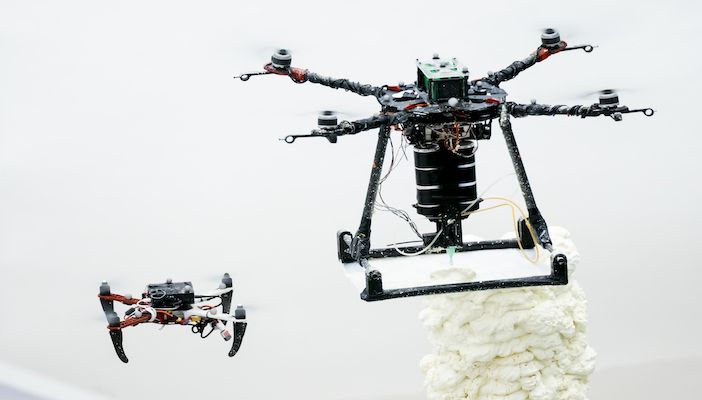Engineers have fitted 3D printers to drones and used them as flying robots capable of repairing buildings and other structures.
Researchers from Imperial College London in the UK and Empa, the Swiss Federal Laboratories of Materials Science and Technology have developed the fleet of bee-inspired flying 3D printers and tested them in the lab. The aim is to use the drones for manufacturing and building in difficult-to-access or dangerous locations such as tall buildings or help with post-disaster relief construction.
The drones can be programmed to use collective building methods inspired by natural builders like bees and wasps who work together to create large, intricate structures.
The drones in the fleet, known collectively as Aerial Additive Manufacturing (Aerial-AM), work co-operatively from a single blueprint, adapting their techniques as they go. They are fully autonomous while flying but are monitored by a human controller who checks progress and intervenes if necessary, based on the information provided by the drones.
Leader of the study Professor Kovac, from Imperial’s department of aeronautics and Empa’s materials and technology center of robotics said, “We’ve proved that drones can work autonomously and in tandem to construct and repair buildings, at least in the lab. Our solution is scalable and could help us to construct and repair building in difficult-to-reach areas in the future.”
Builder and scanner drones
Aerial-AM uses both a 3D printing and path-planning framework to help the drones adapt to variations in geometry of the structure as a build progresses. The fleet consists of BuilDrones, which deposit materials during flight, and quality-controlling ScanDrones that continually measure the BuilDrones’ output and inform their next manufacturing steps.
To test the concept, the researchers developed four bespoke cement mixtures for the drones to build with.
Throughout the build, the drones assessed the printed geometry and adapted their behaviour to ensure they met the build specifications, with manufacturing accuracy of five millimetres.
The proof-of-concept prints included a 2m (6.5ft) high cylinder of 72 layers of a polyurethane-based foam material, and an 18cm (7 in) high cylinder of 28 layers made with a custom-designed structural cementitious material.
The next step in the project is to work with construction companies to validate the solutions and provide repair and manufacturing capabilities, said Imperial College London.
Kovac said, “We believe our fleet of drones could help reduce the costs and risks of construction in the future, compared to traditional manual methods.”





